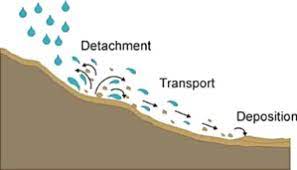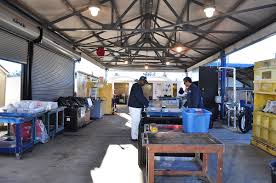Definition, Sources of Sediment and Sediment Transport
Sediment and erosion are closely related concepts in hydrology. The erosion process produces sediment in form of both organic and inorganic materials, which are transported and eventually deposited. This article will examine the sources, transportation process, deposition, impacts, and control measures of sediment.
What is Sediment?
Sediment is naturally occurring material that is broken down by processes of weathering and erosion, and is subsequently transported by the action of wind, water, or ice, and by the force of gravity acting on the particle itself.
In the context of stream hydrology, sediment is inorganic and organic material that is transported by, suspended in, or deposited by streams. Sediment load, which is the quantity of sediment transported by a stream, is a function of stream discharge, soil and land-cover features, weather conditions, land-use activities, and many other factors.
Sediment load carried by streams and rivers can be composed either of fine materials, mostly silts and clays, or larger materials such as sand.
Sources of Sediment
Sediment is a natural product of stream erosion: however, the sediment load may be increased by human activities. Such enhanced sources of sediment in a watershed include unvegetated stream banks and uncovered soil regions, including construction sites, deforested areas, and croplands.
When soils erode, sediments are washed into streams and rivers. Sediment in waterways are often high in areas where river banks are grazed by livestock, on farms with steep slopes cleared of trees, and where there is a lack of riparian vegetation.
Grazing along river banks removes or damages existing vegetation, increases compaction of the soil, and damages the banks of a waterway. With time, the area around a stream will become unstable, prone to slips, and vulnerable to erosion, especially during floods.
Deer can cause sediment loads into waterways because they have a tendency to walk along fenced lines. This activity causes soil compaction and erosion, which may lead to the formation of drainage channels that then transport water and sediment to the nearest stream.
Read Also : How to Reduce the Amount of Wastes Produced
Forest increases soil stability because their roots bind the soil together. When large areas of land are cleared and harvested of trees, the soil becomes vulnerable to erosion as tree roots die and as the land is exposed to direct rainfall.
Trees increase the soil’s ability to take up water, and as a result there is usually a significant increase in the amount of surface water runoff from the surrounding catchment when trees are felled.

Removal of riparian vegetation directly next to a waterway is likely to cause banks to become unstable and prone to slips, thereby increasing erosion, especially during floods. Other impacts that can produce sediment include earthwork for roads and landing sites, and hauling logs across bare slopes.
When land is cleared for urban development, earthworks are required to establish roads and building sites. The exposed soils are prone to erosion and can cause large quantities of sediment to be washed into nearby waterways through surface runoff especially after heavy rain.
Small streams and rivers may also be completely modified through channelization, construction of revetments (concrete structures), and instream barriers (e.g. culverts and dams), and removal of riparian vegetation.
Dams impact on the amount of sediment that moves downstream. Sediments are trapped behind a hydro-dam’s reservoir (hydro-lake) and build up. This reduces the reservoir’s storage capacity. The rate at which this happens varies greatly among hydro-dams.
Dams also reduce the amount of sediment deposited downstream. This increases erosion and scouring and decreases the amount of sediment available to replenish downstream habitats.
The conversion of wetlands or wood lands to cropland can increased soil erosion and the associated sedimentation in streams, particularly when bare soil is exposed. Wind-blown particles from bare soil also contribute to sedimentation problems.
Activities such as dredging and channelization that increase stream slope and velocity can increase the streams erosive capacity and sediment-transport capability. Construction projects within or adjacent to stream can contribute to the sedimentation problems as they dislodge or expose soil and sediment.
Sediment Transport Process
Sediment is transported based on the strength of the flow that carries it and its own size, volume, density, and shape. Stronger flows will increase the lift and drag on the particle, causing it to rise, while larger or denser particles will be more likely to fall through the flow.
Sediment is most often transported by water (fluvial processes), wind (aeolian processes) and glaciers. Beach sands and river channel deposits are examples of fluvial transport and deposition, though sediment also often settles out of slow-moving or standing water in lakes and oceans.
Deserts sand dunes and loess are examples of aeolian transport and deposition. Glacial moraine deposits and till are ice transported sediment.
Rivers and streams carry sediment in their flows. This sediment can be in a variety of locations within the flow, depending on the balance between the upwards velocity on the particle (drag and lift forces), and the settling velocity of the particle. These relationships are given in the following table for the Rouse number which is a ratio of sediment fall velocity to upwards velocity.
Table: Ration of Sediment Fall Velocity to Upwards Velocity.
| ModeofTransport | RouseNumber |
| Bed load | > 2.5 |
| Suspended load 50% suspended | >1.2, < 2.5 |
| Suspended load 100% suspended | >0.8, < 1.2 |
| Wash load | < 0.8 |
If the upwards velocity approximately equal to the settling velocity, sediment will be transported downstream entirely as suspended load.
If the upwards velocity is much less than the settling velocity, but still high enough for the sediment to move, it will move along the bed as bed load by rolling, sliding, and saltation (jumping up into the flow, being transported a short distance then settling again). If the upwards velocity is higher than the settling velocity, the sediment will be transported high in the flow as wash load.
As there are generally a range of different particle sizes in the flow, it is common for material of different sizes to move through all areas of the flow for given stream conditions.
The overall balance between sediment in transport and sediment being deposited on the bed is given by the Exner equation. This expression states that the rate of increase in bed elevation due to deposition is proportional to the amount of sediment that falls out of the flow.
This equation is important in that changes in the power of the flow changes the ability of the flow to carry sediment, and this is reflected in patterns of erosion and deposition observed throughout a stream.
This can be localized, and simply due to small obstacles: examples are scour holes behind boulders, where flow accelerates, and deposition on the inside of meander bends. Erosion and deposition can also be regional: erosion can occur due to dam removal and base level fall. Deposition can occur due to dam emplacement that causes the river to pool, and deposit its entire load or due to base level rise.
Solid sediment load can be divided into two components on the basis of the mode of sediment transport, suspended sediment, and bed-load sediment, each of which is produced by mechanical weathering processes is clearly visible, and is able to settle out of water.
Suspended sediment consists of silt-sized and clay-sized particles held in suspension by turbulence in flowing water. Bed load sediment consists of larger particles which slide, roll, or bounce along the stream bed by the force of moving water.
Read Also : Factors Influencing Soil Moisture
Dissolved load consists of inconspicuous material in solution moving downstream. It is produced by chemical weathering processes, and does not settle out of water.
Sediment yield is the total quantity of sediment transported from a watershed (drainage basin) at a given location in a given period of time. Low suspended sediment yields can be attributed to, among other factors, a region’s low erosion rate.
Permeable soils and low topographic relief, in general, help limit the availability of eroded material from within a watershed. Conversely, relatively impermeable soils and steep topography can yield high erosion rates and therefore greater sediment yield.



